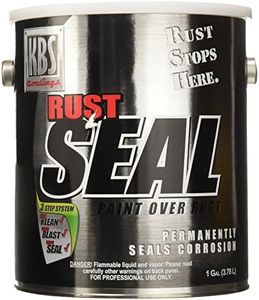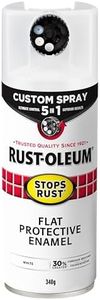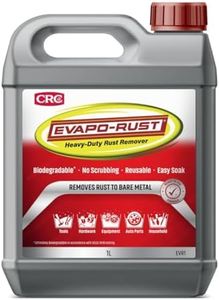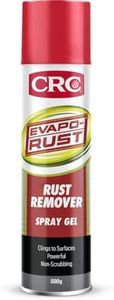We Use CookiesWe use cookies to enhance the security, performance,
functionality and for analytical and promotional activities. By continuing to browse this site you
are agreeing to our privacy policy
10 Best Rust Treatments
From leading brands and best sellers available on the web.Buying Guide for the Best Rust Treatments
When choosing a rust treatment, it’s important to think about what you’re trying to achieve—are you just stopping existing rust, repairing damage, or protecting against future rust? There are plenty of products out there, and each works in a slightly different way. Some change the rust into a stable material, others create a barrier to stop moisture and air, and some basically clean and prep the surface for painting or coating. Understanding how these treatments work and what your surface needs is key to choosing the right one. Take into account the surface type, where it’s used (indoors or outdoors), and how much effort you want to put into application and maintenance.Type of TreatmentThis refers to the method by which the product stops or prevents rust. There are three main types: rust converters (which chemically turn rust into a paintable surface), rust removers (which dissolve and remove rust), and rust preventatives (which form a protective coating to prevent rust formation). Choosing the right type depends on your goal—if you’re dealing with active rust you want to stop, a converter or remover is needed. If you’re more focused on long-term prevention, a preventative is the way to go.
Application MethodRust treatments come in several application forms such as sprays, liquids, gels, or paints. Sprays are quick and good for hard-to-reach areas, while gels and liquids allow more control but may require brushes or sponges. Paints are best when you need both protection and a new finish. Select based on how easy you want the job to be and the size/detail of the area needing treatment. If you have large or flat areas, a brush or roller-on treatment may be best; for spots and nooks, sprays or gels are often easier.
Surface CompatibilitySome rust treatments work best on metals like steel or iron, while others can also be used on aluminum or even non-metal surfaces. It’s important because using the wrong treatment can damage the surface or simply not work. Always check that the product is safe for your specific material, especially if you’re treating things like car parts, tools, or outdoor furniture.
Curing and Drying TimeThis is the amount of time you need to wait after applying the product before it’s safe to touch or paint over. Some fast-drying treatments can be handled within an hour, while others might need several hours or even overnight. If you need to use the item quickly, choose a product with a fast curing time. For bigger projects or things you can set aside, drying time might be less important.
Environmental ResistanceThis refers to how well the treatment stands up to conditions like rain, heat, or salt (for example, on vehicles or outdoor furniture). If your treated item will be outside or exposed to weather, choose a treatment known for strong environmental resistance—these usually offer better long-term protection. If you’re treating something that stays indoors or away from moisture, this feature can be less critical.
Toxicity and SafetyRust treatments can contain strong chemicals, so it’s important to think about safety, especially if you have pets, children, or are working in poorly ventilated areas. Some products are labeled as non-toxic or low-odor and are safer for indoor use, while others require protective gear and good ventilation. Always match your choice to your working conditions and safety needs.














